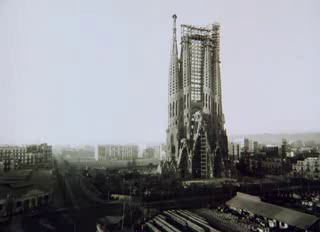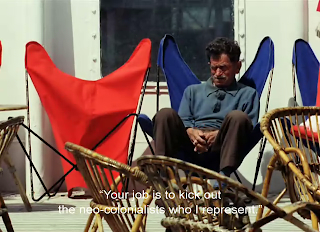With this post, I complete a century on this blog, and it is an excellent co-incidence (as opposed to a devious plan) that this one also gives me an opportunity to summarise my engagement with cinema this year. I watched close to 160 titles this year, which is not much, but a relatively large percentage of those were remarkable or atleast, had permanent merit in them. Below, therefore, are the best films I watched this year (not the ones released this year, but the ones I happened to chance upon), a few images that stuck and a lengthy wishes I have for our national cinema as it were, in the coming years.
---------------------------------------------------------------------------------------------------
 |
| Touki Bouki (1973) / Djibril-Diop Mambety |
Best Titles.
- Le Trou / Jacques Becker
- The Lodger: A Story of the London
Fog / Alfred Hitchcock
- Gate of Flesh / Seijun Suzuki
- Les Vampires / Louis Feuillade
- Marnie / Alfred Hitchcock
- Antonio Gaudi / Hiroshi Teshigahara
- Dr. Mabuse: The Gambler / Fritz Lang
- Statues Also Die / Chris Marker, Alain Resnais
- Zabriskie Point / Michelangelo Antonioni
- Cold Harvest / Isaac Florentine
- À Nous la Liberté / Rene Clair
- Goodbye, Dragon Inn / Tsai-Ming Liang
- Crazy Thunder Road / Sogo Ishii
- Monsieur Verdoux / Charlie
Chaplin
- Sunnyside / Charlie Chaplin
- Attack! / Robert Aldrich
- Muriel or The Time of Return / Alain Resnais
- Blast of Silence / Allen Barron
- The We and the I / Michel Gondry
- Touki Bouki / Djibril-Diop Mambety
- Eyes Without a Face / Georges Franju
- This is Not a Film / Jafar Panahi
- Hugo / Martin Scorsese
- Shock Corridor / Samuel Fuller
- Tinker Tailor Soldier Spy / Tomas Alfredson
Notable, Too.
Pauvre Pierrot / Emile Reynaud
The Beiderbecke Affair / David Reynolds, Frank W. Smith
The Dreyfus Affair / Georges Melies
The Yakuza / Sydney Pollack
---------------------------------------------------------------------------------------------------
Wishlist 2013
This isn't meant to be a manifesto or a call-to-arms, merely the expression of a series of very personal wishes for Indian cinema as it only now begins to enter the 21st Century. While a few titles did gather international appreciation this year, I believe a more permanent change will happen only when we have a setup in place that:
a) facilitates
independent film distribution/production/exhibition; this will include funding agencies dedicated
exclusively to fund ideas of independent film producers - and they can be both
offline and online. These may include funding websites such as Kickstarter or
Indiegogo, but more essentially, agencies like the NFDC of yore, development
labs and grants that are dedicated to the cause of alternative filmmaking. A
serious movement has been made in this direction in recent times by the revived
NFDC (which was under a serious threat of being closed in 2009) but much more
needs to be done – funding agencies will have to cast their net wider, so that
the representation at international festivals is multilingual as well as
multi-ethnic, which really is one of the unique features of our cinema. In this regard, the support given to
Haobam Paban Kumar, who made an important political film in AFSPA 1958 is an interesting case-study.
To extend this, this will also entail a support-system, in terms of funding,
exhibition and distribution of documentary filmmaking in the country, which is
where some of the most interesting work is being conducted right now.
Filmmakers such as Rajesh Jala, Amlan Dutta (and his brother), Faiza Ahmed
Khan, Haobam Paban Kumar and of course, Anand Patwardhan can only gain from
consistent support. In this case, an agency like PSBT or Doordarshan may also
like to revise its methods of granting funds only to established filmmakers and
not to younger, lesser known faces who may have important areas to direct their
cameras at but not biological age to represent their prospective quality, and helps institute,
c) repertory theatres, independent art-house cinemas, revival houses
that are dedicated to programming of contemporary/modern/classic world cinema
retrospectives, screenings and rental stores (again, whether online or offline;
and rental stores, not streaming sites) of obscure alternative titles that are
made available in a legitimate and legal way - not a storehouse of piracy for
even if I subscribe to it out of compulsion, their quality is always suspect
and well, it is illegal so it is not a part of a regular framework.
d) a set of societies for film critics such as the
international FIPRESCI (the Indian chapter is represented currently by individuals who were excellent critics back in the day, but aren't active anymore) but the more local film society circles in cities such
as Austin, Boston, New York, Los Angeles - thereby allowing criticism to exist
as a fully-formed profession rather than a weekly response to the 'latest
releases' - in that, specific grants/institutions should be allocated to
aspiring film critics and the work of established serious writing on film
should be routinely awarded. As such, there should also be a network of critics
that organises frequent seminars, discussions, student exchange groups that
these critics interact with, and a general filmmaker-critic interaction that is
literally absent in the country (the new Baradwaj Rangan- Mani Ratnam interview book is an
excellent starting point).
e) in the extension of above, print journals/magazines/platforms
that are involved in the serious and sustained publication of serious writing
on cinema. In this regard, Cinemaya
which was run for 21 years, Deep Focus
which has recently been revived in Bangalore, or film journals such as Close-Up or Movement, which were active during the 1960s and the 70s could be
important precedents.
f) an agency instituted and much more essentially,
funded for the preservation of our cinematic legacy – in this regard, the work
in the recent years of a government organ like NFAI has been commendable, but
truth be told, I believe it was only under the able leadership of the late Mr. Vijay
Jadhav, who died end 2010, that the NFAI could really fulfill the promise of
its early days under Mr. P.K. Nair. As such, there is a need for more awareness,
more involvement of the youth and needless to say, formal courses at film
schools/institutes for people interested in film preservation (I know they have
instituted a 6 weeks course but that is nothing, and means nothing). Currently,
the NFAI has 11000 titles with it and Films Division (who still haven’t
released a boxset of the films of S Sukhdev, SNS Sastry and Pramod Pati) have
another 8000 films. 4000-5000 titles made in the country since the dawn of
cinema are irreparably and permanently lost while around 17000 titles are in
active circulation. But what’s more important is the urgent need to institute a
culture of curiosity in regards to old titles – even if NFAI does have prints
of silent films, it is not as if enough demand is being made to make them
available to the viewing public. The screening of Throw of Dice (1928) at Trafalgar Square which was attended by
10000 individuals should be an important point of discussion – it means
film-lovers in this country are curious about India’s silent film. In this
regard, the work of historian B.D.Garga and critic Chidananda Dasgupta should
be read and circulated widely. Important steps have been taken in the recent
past with the issue of the DVD boxset of three of Phalke’s films (out of which,
Krishnajanama (1919) is even
available on Youtube) and also a number of screenings of Raja Harishchandra (1913) to mark the centenary of that film, but
more needs to be done. A government
funded autonomous agency, perhaps NFAI itself, should now be funded to build
its own underground vault of our cinema and should be given enough money to
help us locate our films from world over and get those prints back home.
g) which brings me to the point of the need of
film education - film as a subject should be included in school curriculum, but
even at the level of higher education, there should be an opportunity for the
students to seriously consider cinema as a profession and not a passing hobby -
this will happen only when there is a proper film school that is cheap/affordable/government subsidised
and creates professionals with individuals sensibilities and not individuals
with professional sensibilities. In this case, looking at the Lodz Film School
(which FTII was initially modelled on alongwith VGIK, Moscow), VGIK Moscow and
of course, the best of 'em all, the Beijing Film Academy will help immensely.
Also film schools and film education should be exempted from five-year plans -
because these need a sustainable fifty-year plan to make any real change.
h) they will need to reorganise and revitalise the
FFSI (Federation of Film Societies in India) - nothing interesting is happening
on the Film Society front in the country, except in the Western Region where
individuals like Sudhir Nandgaonkar are instrumental in putting up interesting
programmes in colleges/universities as well as organizing film appreciation
workshops. The FFSI main headquarters in Delhi are housed in one room and the
rules for registering a society are archaic. An impetus from the central
government wherein a society is setup in every city (if not every school, ala
FILMCLUB in UK) is much needed. The older film societies such as Chitralekha in
Kerala, Suchitra in Bangalore, the now-defunct Katha Center for Film Studies in
Mumbai and Cine-Central need to be given further impetus to refresh their
objectives and spread out to other parts of the nation with their experience.
In this regard, we also need more serious film festivals - the work of the
Baburao Painter Society in the Kolhapur Intn't Film Festival (and on a side,
the Pune Intn'l Film Festival), Jan Sanskriti Manch in Gorakhpur and Gurpal
Singh/Swagata Sen in Puri is exemplary - more such festivals should be
organised with a regular incentive of both income and social change. The
International Film Festival of Goa should quickly be severed from the
government and made autonomous with an ambitious film professional who should
be selected after a series of selection rounds as the director of the festival.
---------------------------------------------------------------------------------------------------
A Few Resonant Images
































































































